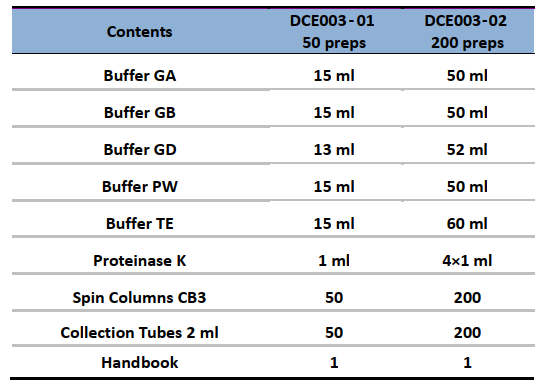The Blood & Tissue DNA Kit was created specifically for isolating genomic DNA from a variety of sample types, such as animal blood (up to 1 ml), cultured cells, and tissues usually found in life science. The Kit offers superior purity and stable quality DNA free of proteins and other organic compounds thanks to its unique silica-membrane technology and buffer solution. Purified DNA can be utilized directly in molecular biological experiments like PCR, restriction enzyme digestion, Southern hybridization, and the construction of DNA libraries. Animal blood (less than 1 mL), cultured cells, and tissues usually encountered in life science are all acceptable sample types.
Yield
| Source | DNA Yield |
| Whole blood from mammalian (100-400 μl) | 3-10 μg |
| Whole blood from bird or amphibian (5-20 μl) | 5-40 μg |
| Cultured cells (106-107 cells) | 5-30 μg |
| Tissue (30 mg) | 10-30 μg |
Storage:
Store at room temperature (15-25℃)
Components:

Specifications:
| Features | The unique silica membrane technology provides high purity and stable quality DNA free from proteins and other organic compounds. High DNA yield, excellent repeatability. |
| Application | The high pure genomic DNA can be used directly in downstream experiments such as PCR reaction, restriction enzyme digestion, Southern hybridization and DNA library construction. |
| Species Category | animals |
| Sample type | animal blood (≤ 1 ml), cultured cells, and tissues commonly encountered in life science |
Ensure that Buffer GD and Buffer PW have been prepared with appropriate volume of ethanol (96-100%) as indicated on the bottle and shake thoroughly.
- Sample preparation
- Add 20 μl Proteinase K, mix thoroughly by vortex.
- Add 200 μl Buffer GB to the sample, mix thoroughly by vortex, and incubate at 70°C for 10 min to yield a homogeneous solution. Briefly centrifuge the 1.5 ml microcentrifuge tube to remove drops from the inside of the lid.
- Add 200 μl ethanol (96-100%) to the sample, and mix thoroughly by vortex for 15 s. A white precipitate may form on addition of ethanol. Briefly centrifuge the 1.5 ml microcentrifuge tube to remove drops from the inside of the lid.
- Pipet the mixture from step 4 into the Spin Column CB3 (in a 2 ml collection tube) and centrifuge at 12,000 rpm (~13,400 × g) for 30 s. Discard flow-through and place the spin column into the collection tube.
- Add 500 μl Buffer GD (Ensure ethanol (96-100%) has been added) to Spin Column CB3, and centrifuge at 12,000 rpm (~13,400 × g) for 30 s, then discard the flow-through and place the spin column into the collection tube.
- Add 600 μl Buffer PW (Ensure ethanol (96-100%) has been added) to Spin Column CB3, and centrifuge at 12,000 rpm (~13,400 × g) for 30 s. Discard the flow-through and place the spin column into the collection tube.
- Repeat Step 7.
- Centrifuge at 12,000 rpm (~13,400 × g) for 2 min to dry the membrane completely.
- Place the Spin Column CB3 in a new clean 1.5 ml
a. For blood, please use 200 μl fresh, frozen, or anticoagulant-adding blood. If less than 200 μl, please make up with buffer GA to 200 μl.
b. If the sample is blood from poultry, birds, amphibians, of which red blood cells have nucleolus, the amount should be reduced to 5-20 μl and adjust the volume to 200 μl with buffer GA.
c. The adherent cells should be treated to cell suspension first, then centrifuge the cells for 1 min at 10,000 rpm (~11,200 × g), then discard the flow-through and re-suspend cell pellet in 200 μl buffer GA.
d. Animal tissue (spleen<10 mg) should be treated to cells suspension first, then centrifuge at 10,000 rpm (~11,200 × g) for 1 min, then discard the flow-through and re-suspend cell pellet in 200 μl buffer GA.
If the sample is tissue: incubate at 56°C until the tissue is completely lysed.
microcentrifuge tube, and pipet 50-200 μl Buffer TE directly to the center of the membrane. Incubate at room temperature (15-25°C) for 2-5 min, and then centrifuge for 2 min at 12,000 rpm (~13,400 × g).



